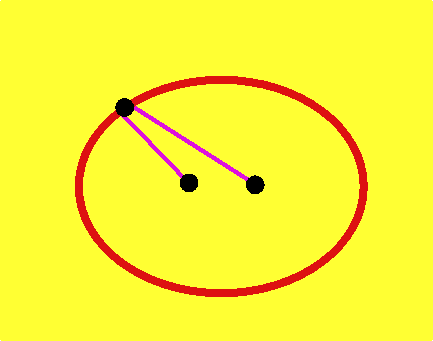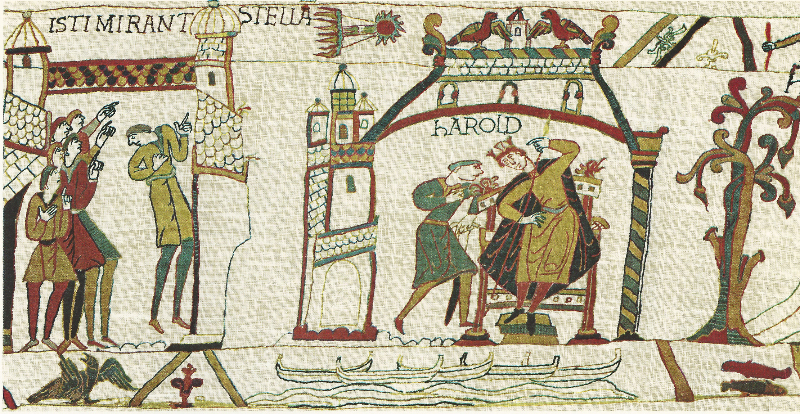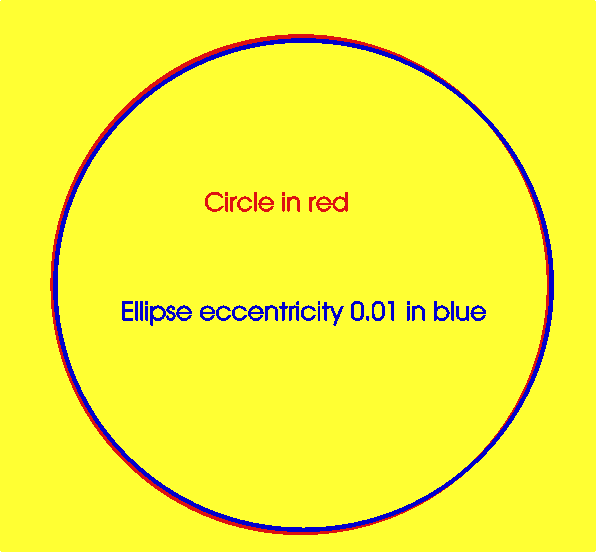Our word comet comes from a Latin word which means hairy tail, but they were also known by a name which translates into English as broom star.
Here we have a comet which was visible in 2022.
Comets go round the Sun, like the Earth and the other Planets, because of the Sun’s gravity - this is described on another Page - but they are much smaller (seldom more than a few kilometres in diameter) and unlike the Earth and the the other planets, which go round the Sun in very nearly circular orbits they have very elliptical orbits.
Sam and his friends go to the beach to find out about ellipses. They take with them a 32 m rope and some old cricket stumps.
First they push one of the stumps into the ground and fasten both ends of the rope to it and then use the rope folded in the middle and another stump to mark out a circle in the sand.

Now they put a stump into the ground 24 m from the first and fix one end of the rope to one stump and the other end to the other. What they draw in the sand now with the third stump is a special shape called an ellipse.

The two stumps are the foci (singular focus) of the ellipse. The two straight lines from the foci to any point on the ellipse always add up to the same length, in this case 32 m. A circle has a diameter but an ellipse has a major axis and a minor axis. For this ellipse the major axis is 32 m and the minor axis is about 21 m.
You can change the shape of an ellipse by keeping the length of the rope the same but changing the distance between the foci. They make another ellipse in the same way, with the foci 8 m apart.

The major axis is 32 m and the minor axis about 25 m.
The eccentricity of an ellipse is the ratio of the distance between the foci to the major axis, so it must be between zero and one. For the first ellipse it is 24 ÷32 or 0.75 and the second 8 ÷ 32 or 0.25.
All comets go round the Sun in very eccentric ellipses with the Sun at one focus, not in the middle. This means that their distance from the Sun is not constant, when a comet is at perihelion (when it is closest to the Sun) it may be nearer to the Sun than Mercury, but at aphelion (when it is furthest from the Sun) it may be thousands of times further from the Sun than Neptune. The nearer it is to the Sun the faster it moves.
The Sun is shooting vast numbers of charged particles into space, these form what is called the solar wind. The “solid lumpy thing” which forms the main body of the comet is called the nucleus. As the comet approaches perihelion the nucleus gets more heat from the Sun and starts to warm up and it begins to give off gases, and these form a glowing coma round it, making the comet visible, initially only with a telescope but sometimes as it gets still nearer the Sun to the naked eye - most do not, there are usually only one or two naked eye comets a year. The solar wind will push the glowing gases away from the comet, making its tail, so the tail always points away from the Sun.
Here is a painting by Lieve Verschuier of the Great Comet of 1680 over Rotterdam. This comet was so bright it could be seen even during the day, and its tail is among the longest tail ever recorded - several people in the crowd are shown holding up cross staffs, a staff with one or two cross pieces, which can by used by sailors and other travellers and astronomers to make simple navigational and astronomical measurements.

Comets are a part of the solar system and many are discovered by and named after amateur astronomers: today most professional astronomers are pointing their multi-million dollar telescopes at objects far further away than anything in the solar system. Sam did not discover this comet for himself, but there is a comet web site which tells you everything about all comets which have been detected approaching the Earth, so he knows where to point his telescope before it becomes a naked eye object.
Comets are going round the Sun but all at different rates, some once in less than a hundred years and some only once in more than a thousand years, depending upon how far they are from the Sun at aphelion - remember that the further they are from the Sun the more slowly they move, and also that the more elliptical their orbit the closer they are to the Sun and the faster they move when they are at perihelion.
All the objects in the Kuiper Belt and Oort Cloud are circling the Sun because of the Sun’s gravity but they are also being affected by the gravity of all the planets, particularly the giant planets Jupiter and Saturn. These are going round the Sun at different rates so will be different distances from the objects in the Kuiper Belt and Oort Cloud. Sometimes their combined gravity will be enough to put a Kuiper Belt or Oort Cloud Object (or occasionally an asteroid) into a different, much more elliptical, orbit. Most comets start their life in the Kuiper Belt or Oort Cloud in this way.
Comets starting in the Oort Cloud contain the same materials from which the Solar System was formed, so they can tell us a lot about its origins. In 2015 a spacecraft called Rosetta orbited a comet and soft-landed a probe on its surface.
The nucleus of a comet is often described as a “dirty snowball.” As it gets nearer the Sun it gets hotter and some of the water evaporates, so a comet leaves some of the dirt trapped in it behind, like the muddy footprints you leave across the floor, except that this trail is there for ever. If the Earth passes through this trail we get a meteor shower.
Naked eye comets appear from nowhere and disappear into nowhere so they were of great interest to the early astronomers. Records, particularly Chinese records, of naked eye comets go back for thousands of years, and more than six thousand have so far been recorded (about one or two a year!)
For thousands of years Man divided everything into terrestial objects (of the Earth) and celestial objects (of the sky). Everything associated with the Earth, including the atmosphere and clouds and shooting stars, was terrestial - they realised shooting stars were terrestial because they sometimes hit the Earth! Everything celestial, in the sky, was a star: the Sun, Moon, Mercury, Venus, Mars, Jupiter and Saturn were the moving stars, and what we today call just “the stars” were the fixed stars. (They did not know about Uranus and Neptune until after the invention of the telescope in about 1600 CE.) They were able to predict the movements of everything celestial, except comets, with stunning accuracy, and saw these movements as something absolutely unchanging from generation to generation. Comets were totally unpredictable, and upset the whole order of the Heavens, and so were often regarded as omens of misfortune: something bad was about to happen.
The most famous comet is named after the English astronomer Edmund Halley (1656 - 1742). Halley is normally pronounced to rhyme with valley. In 1705 he realised that the orbital data (the way it moved round the Sun) for the comet of 1682 was the same as that for the comets of 1607 and 1531. He thought therefore that they were the same comet, returning about every 75 years, and he predicted its reappearance in 1758. He died before then but when it did reappear it was named after him. Its last appearance was in 1986 and its next appearance will be in the summer of 2061. Halley’s work began our modern understanding of comets.
Working backwards, we can say that the comets of 1066 CE, shown in the Bayeux Tapestry, and 1059 BCE (recorded by the Chinese) were Halley’s Comet.
The Bayeux Tapestry was made in about 1070 CE. It is not really a tapestry, it is a very long piece of embroidery on a linen strip about 69 m long and about 50 cm wide and showing scenes from the Norman Invasion of England in the form of what today would be called a strip cartoon. Here is the scene showing the comet.

ISTI MIRANT STELLA is usually translated as “These men look in wonder at the star.”
Astrologers are telling King Harold that the comet means that bad things are going to happen to him. The ghost ships at the bottom are where he is dreaming about the Norman invasion fleet.Most wall charts of the Solar System and simple accounts of it show the planets going round the Sun in circular orbits, with the Earth 150 million kilometres from the Sun, but in fact the Earth and the other planets go round the Sun, and the Moon goes round the Earth, in orbits which are very slightly elliptical. This is why we sometimes get annular eclipses. But it is also important that we know this if we want to understand why at the beginning of the 17th Century people began to accept that the Earth goes round the Sun even though they can actually see the Sun going round the Earth. This is described more fully on another Page.
For the Earth, the mean distance from the Sun is 149.6 million kilometres, perihelion is 147.1 million kilometres and aphelion is 152.1 million kilometres and the eccentricity is 0.01.

© Barry Gray October 2022